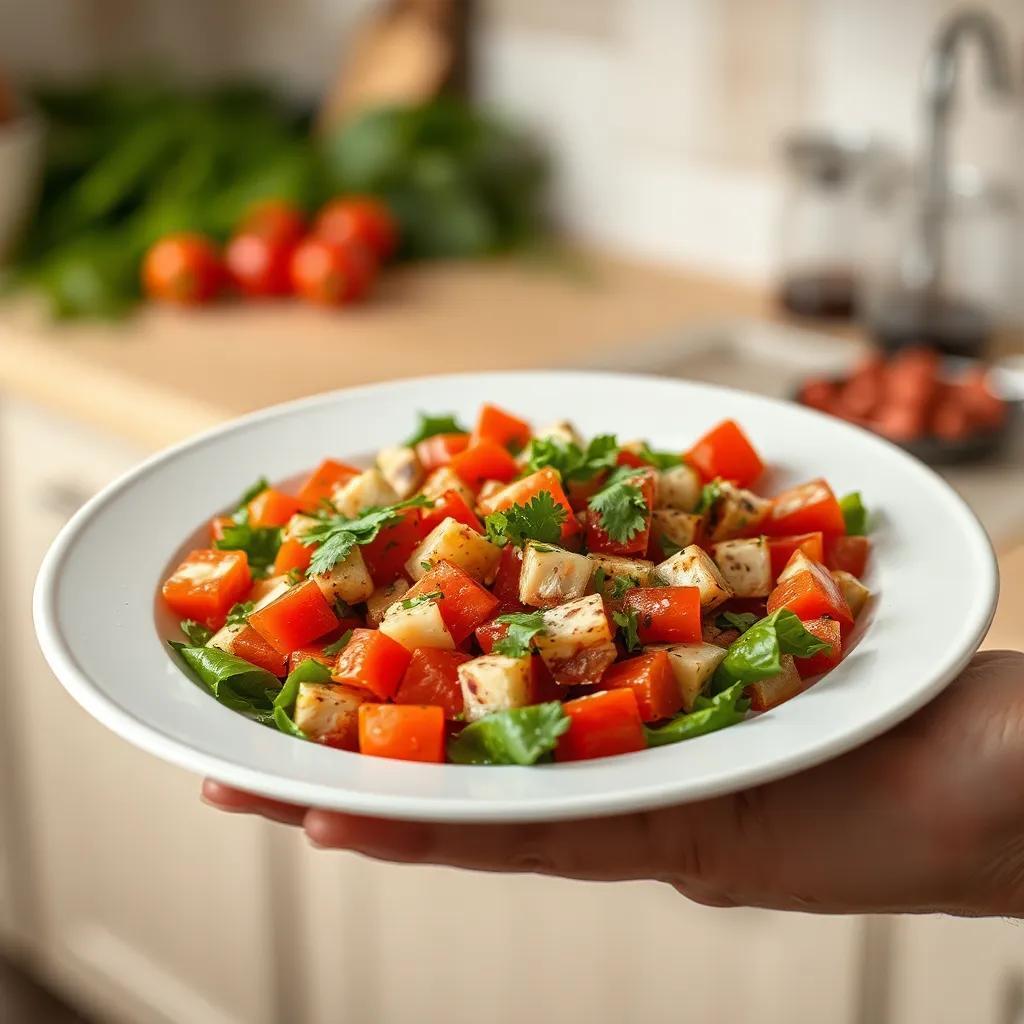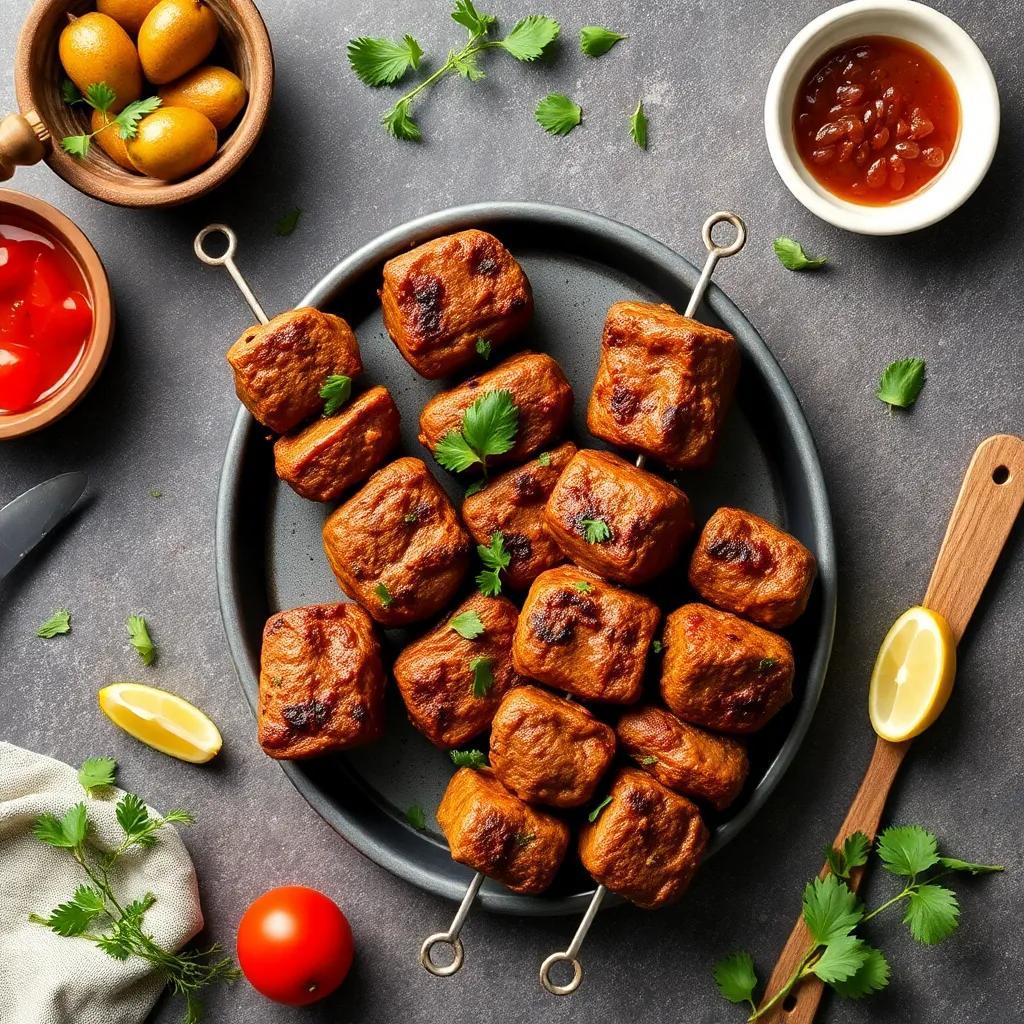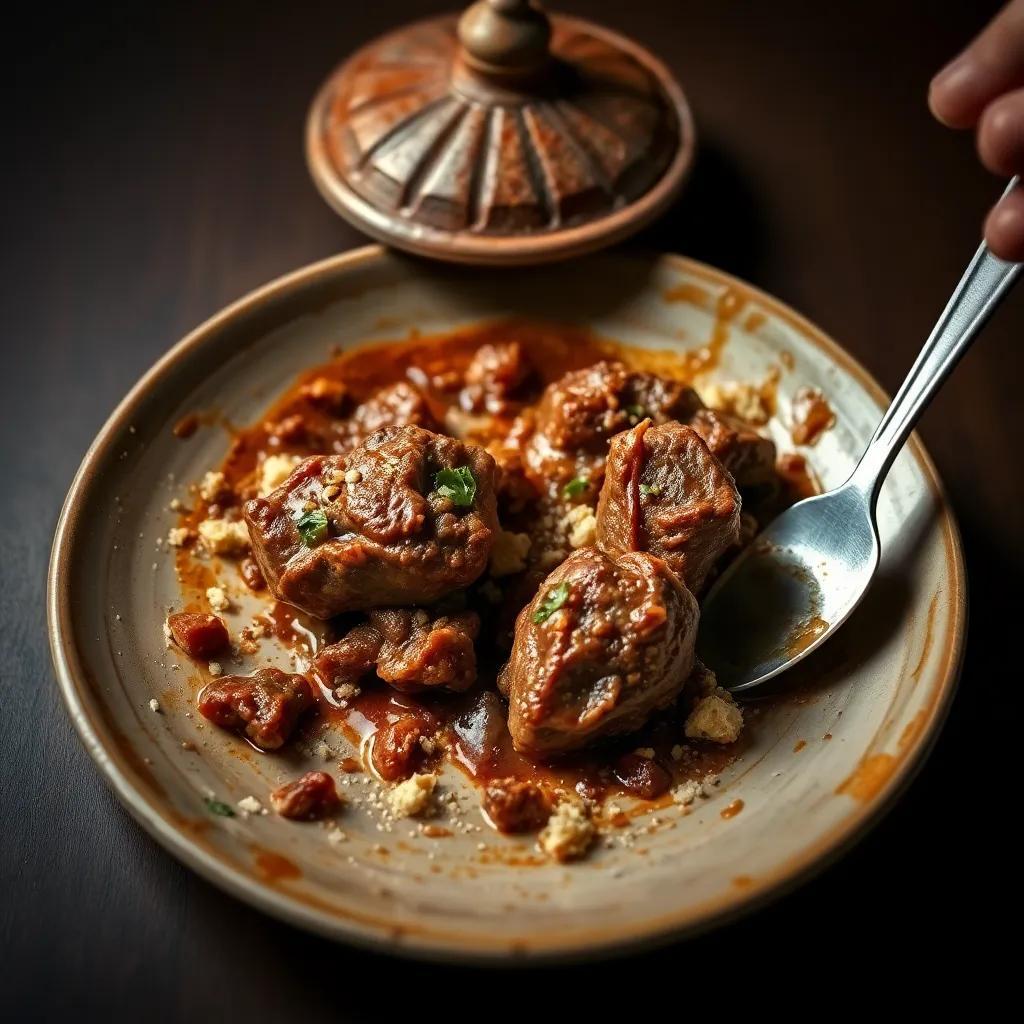Fresh & Flavorful Tabbouleh Recipe: Easy, Vegan, Gluten-Free Salad
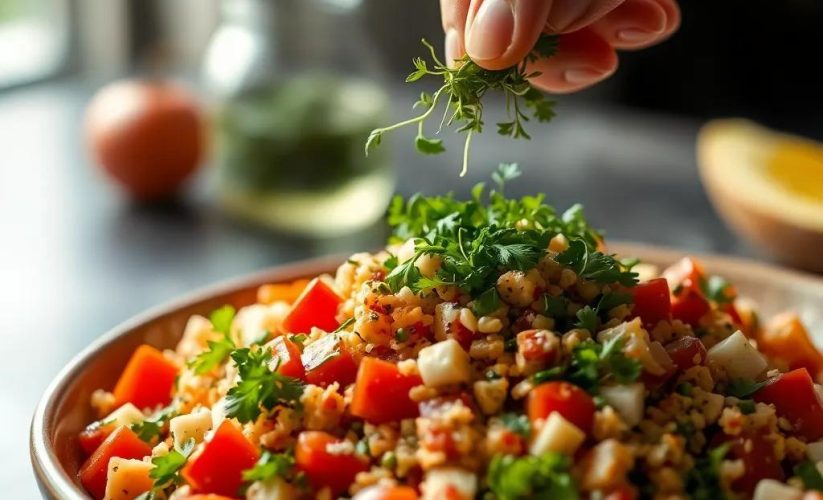
Fresh & Flavorful Tabbouleh Recipe: Easy, Vegan, Gluten-Free Salad
🌍 Cuisine: Middle Eastern
⚙️ Difficulty: Easy
Ingredients
Nutrition Facts
120
Instructions
- Prepare the bulgur by soaking it in cold water for 20 minutes until soft. If using quinoa, rinse and cook according to package instructions, then allow to cool.
- While the bulgur or quinoa is soaking/cooking, finely chop the parsley, mint leaves, and green onions.
- Dice the tomatoes and chop the cucumber if using. Place all chopped vegetables and herbs into a large mixing bowl.
- Drain the bulgur thoroughly, pressing out excess water, and add it to the bowl with the vegetables and herbs.
- In a small bowl, whisk together the freshly squeezed lemon juice, olive oil, salt, pepper, and optional ground cumin.
- Pour the dressing over the salad ingredients in the large bowl.
- Toss everything together gently but thoroughly to combine all flavors evenly.
- Taste and adjust seasoning with more salt, pepper, or lemon juice if desired.
- Let the tabbouleh rest in the refrigerator for at least 10 minutes before serving to allow flavors to meld.
- Serve chilled or at room temperature as a refreshing salad or side dish.
Serving Suggestions
- Serve tabbouleh alongside grilled falafel for a complete vegan meal.
- Use as a fresh filling in stuffed grape leaves or lettuce wraps.
- Pair with warm pita bread and hummus for a light Mediterranean lunch.
- Add a scoop of tabbouleh on top of roasted vegetables or grain bowls for extra flavor.
- Enjoy as a side salad with grilled chicken or fish for non-vegan options.
- Mash avocado and mix into tabbouleh for a creamy twist and added richness.
- Top tabbouleh with a sprinkle of toasted pine nuts or sumac for extra texture and zest.
Table of Contents
- Intro
- Ingredient Notes
- Tips & Variations
- Leftovers & Storage
- Behind the Recipe
- FAQ
- Your Turn in the Kitchen
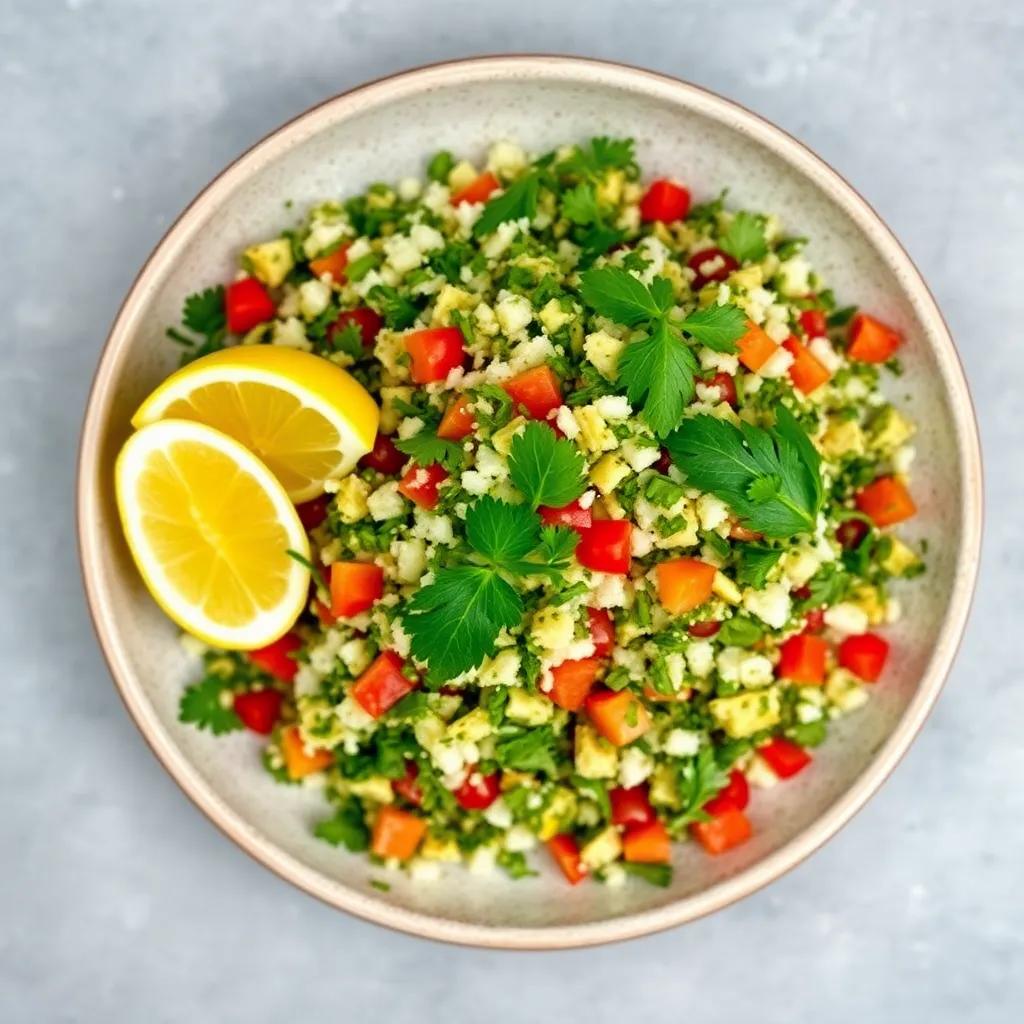
Intro
Tabbouleh is much more than just a salad—it’s a vibrant celebration of fresh flavors and wholesome ingredients that come together effortlessly. This recipe invites you to enjoy a dish that feels light yet satisfying, with a refreshing zest that brightens up any meal. Perfectly suited for warm-weather lunches, casual gatherings, or as a bright side to complement an array of dishes, tabbouleh offers a welcome burst of green herbs and tangy notes that awaken the palate.
One of the best parts about this recipe is how approachable it is—no fancy techniques or long cooking times, just a few simple steps that yield a beautifully balanced salad every time. Whether you’re new to Middle Eastern cuisine or a seasoned fan, this tabbouleh adapts easily to your kitchen, making it ideal for quick meal prep or entertaining guests. Its naturally vegan and gluten-free nature means everyone at the table can enjoy it, and its fresh ingredients make it a perfect counterpoint to heavier fare, adding brightness and texture with every bite.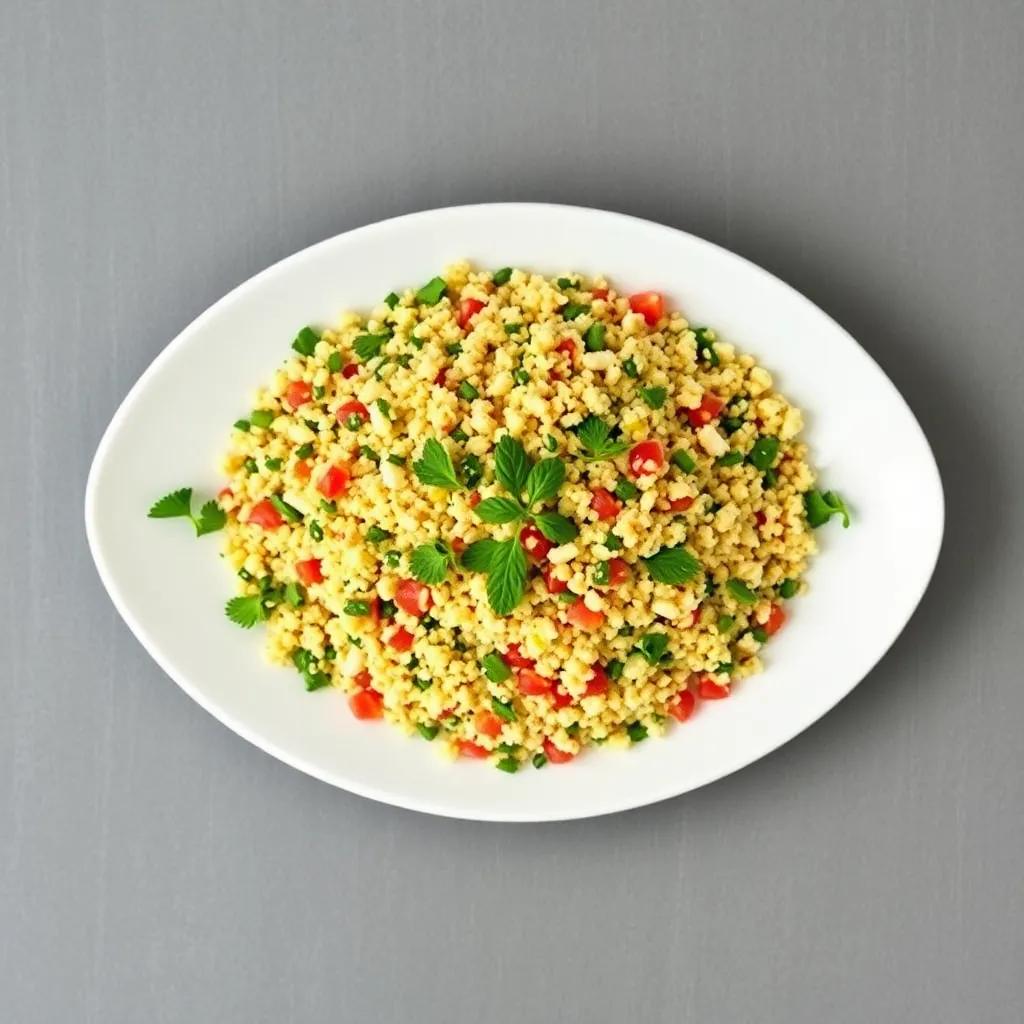
Ingredient Notes
When it comes to crafting an exceptional tabbouleh, a few key ingredients truly make all the difference in flavor, texture, and authenticity. Here’s a closer look at some standout components and how to get the most from them:
Fresh Parsley
Parsley is the star of this salad—not just a garnish but the green heart of tabbouleh. Opt for flat-leaf parsley, which tends to have a more robust flavor and vibrant color compared to its curly counterpart. When buying, look for bunches that look bright and crisp with no wilting or yellow spots. Wash and dry thoroughly before chopping finely, as water can dilute the dressing’s zest. If flat-leaf parsley is unavailable, curly parsley can work, though the flavor will be milder.
Fine Cracked Bulgur or Quinoa
Traditional tabbouleh calls for fine cracked bulgur, which soaks quickly and offers a delicate chewy texture without cooking. For gluten-free diners, quinoa is a fantastic substitute that provides a similar nutty flavor and protein boost. When purchasing bulgur, choose the finest grain for the lightest texture—coarser bulgur will alter the salad’s characteristic feel. If using quinoa, rinse it well to remove any bitterness and let it cool completely before mixing to keep the salad fresh and fluffy.
Fresh Mint Leaves
Mint adds a cooling, aromatic layer that brightens the salad and balances the earthiness of parsley and bulgur. Choose fresh, vibrant mint leaves that are fragrant without any signs of browning or drying. Remove the tougher stems before chopping to avoid bitterness. If fresh mint isn’t accessible, dried mint can be used sparingly—about a teaspoon—though the fresh version is highly recommended for that signature garden-fresh lift.
Extra Virgin Olive Oil
The dressing’s richness and silkiness hinge on a good quality extra virgin olive oil. Look for oils labeled “cold-pressed” and “extra virgin” to ensure a fresh, fruity flavor that complements the lemon juice rather than overpowering it. A more robust, peppery olive oil can add complexity, but smoother varieties work well for those who prefer subtlety. Avoid using generic or light olive oils, as they lack the depth and quality that elevate this simple salad.
By giving these ingredients the care they deserve—selecting the freshest herbs, the right grain, and quality oil—you set the foundation for a tabbouleh that’s truly vibrant and flavorful, capturing the essence of Middle Eastern freshness with every bite.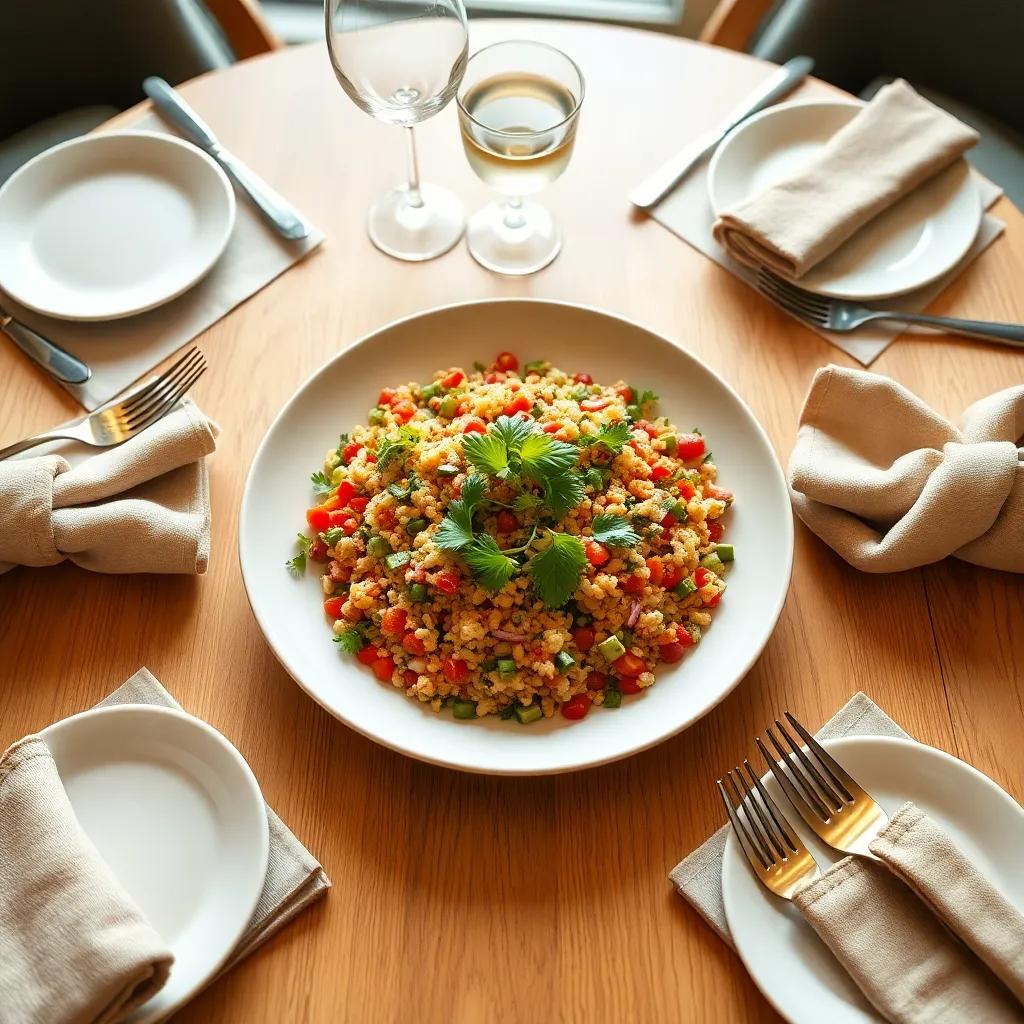
Tips & Variations
To elevate your tabbouleh and make it uniquely yours, consider these tips and creative variations that suit a range of tastes and dietary needs:
- Master the chopping: The texture of tabbouleh is all about finely chopping the herbs and vegetables. Use a sharp knife or a mezzaluna to achieve that perfect delicate consistency. Avoid pulsing herbs in a food processor, which can turn them mushy and release bitterness.
- Balance the moisture: Bulgur and quinoa both absorb liquid differently. If your salad feels too watery after mixing, drain the grain well or gently press it with a paper towel before adding. If it seems dry, add a splash more lemon juice or olive oil to brighten and loosen the mix.
- Customize your greens: While parsley is essential, feel free to experiment by blending in other fresh herbs such as cilantro, dill, or even a handful of arugula to add a peppery bite. These subtle shifts can add new layers of flavor without straying too far from tradition.
- Switch up the grains: Although fine cracked bulgur is classic, quinoa makes this recipe gluten-free and adds protein. For a different twist, try finely chopped cauliflower “rice” or millet for a grain-free or nutty alternative that keeps texture interesting but light.
- Add seasonal veggies: Beyond cucumber and tomatoes, consider mixing in diced radishes, shaved fennel, or roasted peppers for additional crunch and color. These variations tailor the salad to seasonal availability and provide fresh bursts of unexpected flavor.
- Spice it up: The optional pinch of ground cumin works wonders adding a warm, earthy undertone. For a bolder approach, sprinkle in a little smoked paprika, sumac, or Aleppo pepper to introduce subtle heat and aromatic complexity.
- Make it a meal: Boost the protein content by folding in chickpeas, cooked lentils, or toasted nuts like pine nuts or slivered almonds. This turns tabbouleh from a side salad into a satisfying standalone dish without compromising its freshness.
- Adjust acidity: Lemon juice is key to the bright, tangy character of tabbouleh. If you prefer a different citrus note, try lime juice or even a splash of pomegranate molasses for a subtly sweet and tart contrast.
- Vegan and allergy-friendly tips: This recipe is naturally vegan and gluten-free as long as you use quinoa or gluten-free bulgur. For nut-free versions, skip any nut toppings and use seeds like toasted pumpkin or sunflower seeds for crunch instead.
- Serving ideas to experiment: Use tabbouleh as a topping for avocado toast, a vibrant filling for vegan wraps, or a fresh garnish on creamy hummus or baba ganoush. Its flexibility makes it a fantastic base to build upon culinary creativity.
With these thoughtful tweaks and mindful techniques, you can keep your tabbouleh exciting every time you prepare it—whether honoring tradition or making it your own.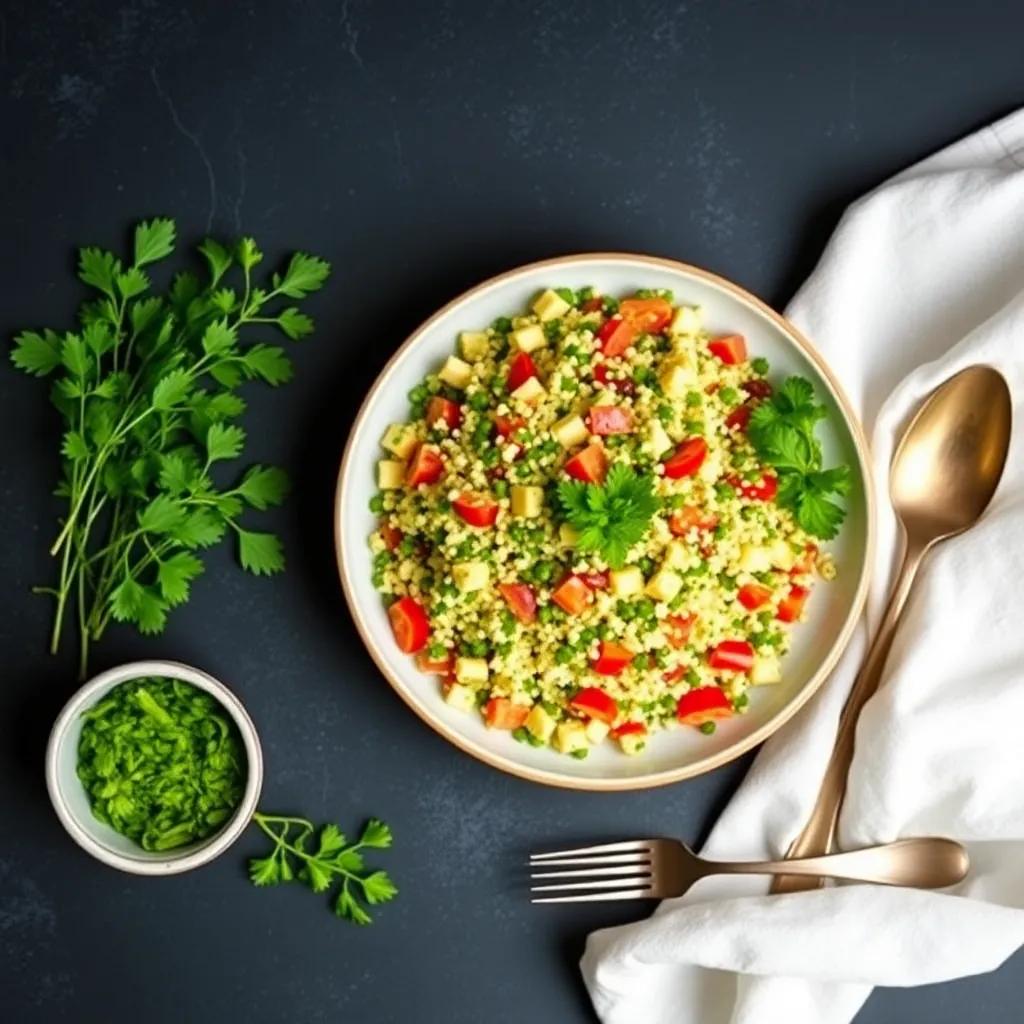
Leftovers & Storage
Storing leftover tabbouleh properly is key to keeping its vibrant freshness and distinct flavors intact. Because this salad features delicate fresh herbs, juicy tomatoes, and a lemon-olive oil dressing, it’s best enjoyed within a short window to savor its crisp texture and bright notes.
For refrigeration, transfer your tabbouleh into an airtight container—glass or BPA-free plastic works best to prevent odor absorption and maintain freshness. Place the container in the coolest part of your fridge, ideally on a middle shelf rather than the door, to keep the temperature steady. Leftover tabbouleh will stay fresh and flavorful for up to 2 days when stored this way. Beyond that, you may notice the herbs begin to wilt, the tomatoes release more juice, and the overall salad softens.
If you plan to prepare tabbouleh in advance or want to enjoy it later in the week, consider assembling the grain and dressing separately from the herbs and tomatoes. Store these components in separate containers and combine just before serving to preserve texture and brightness.
Freezing tabbouleh is generally not recommended, as the fresh vegetables and herbs tend to become watery and lose their crispness upon thawing, resulting in a mushy texture and dull flavor. If you must freeze, do so only with the grain portion (bulgur or quinoa) before mixing, and thaw it fully before adding fresh produce.
For convenient meal prep and packed lunches, tabbouleh is a fantastic choice since it travels well when chilled. Use a sturdy, leak-proof container to prevent dressing spills. Packing the salad with a small lemon wedge or extra olive oil on the side allows a quick flavor refresh at mealtime if the salad seems slightly dry after sitting a while.
When reheating is desired (though often unnecessary), bring the tabbouleh to room temperature or enjoy it chilled — warming it will wilt the herbs and alter the fresh, zesty character that makes this salad so delightful.
In summary: store your tabbouleh chilled in airtight containers, separate components if prepping early, and consume within 1-2 days for the best eating experience. This ensures every forkful remains a lively burst of freshness—a hallmark of this easy, vegan, gluten-free Middle Eastern favorite.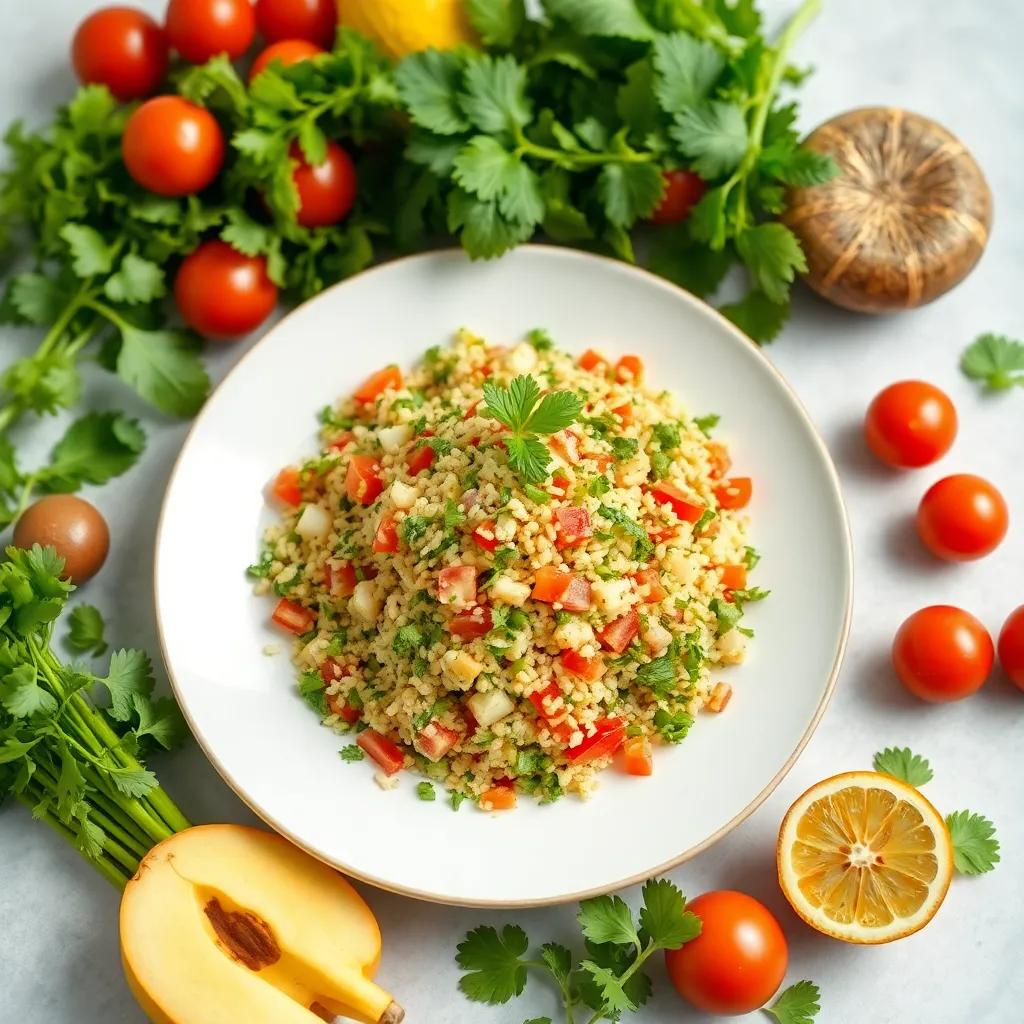
Behind the Recipe
Tabbouleh is a dish deeply rooted in the culinary traditions of the Levant—an area encompassing Lebanon, Syria, Palestine, and Jordan—where it has long been cherished as a bright, herb-forward salad that celebrates the bounty of the Mediterranean garden. Traditionally, it was served as part of a mezze platter, a collection of small dishes meant to be shared, encouraging conviviality and connection around the table. The vibrant green of parsley, the tang of lemon, and the nutty bulgur come together in a harmonious balance that has made tabbouleh a beloved staple both locally and worldwide.
This recipe, while simple and approachable, traces back to centuries-old customs where each household’s version would reflect what was fresh and available—sometimes heavier on herbs, sometimes more grain, occasionally enhanced with regional spices or seasonal vegetables. Its naturally vegan and gluten-free qualities have made it a recipe that transcends time and culture, fitting effortlessly into modern dietary preferences without losing its authentic character.
On a personal note, many cooks find joy in the meditative process of finely chopping the herbs and whisking the dressing—a ritual that slows down the pace of daily life and invites mindfulness into the kitchen. Preparing tabbouleh can become an act of care, whether making a quick lunch or a dish to share at a festive occasion. Each bite carries forward a story of tradition, family, and the simple yet profound pleasure found in fresh, wholesome ingredients combined with intention and care.
FAQ
Can I make tabbouleh without bulgur if I’m gluten-free?
How long can I store tabbouleh in the fridge?
Can I prepare tabbouleh in advance for a party?
Is it possible to add protein to make it more filling?
How can I adjust tabbouleh if I’m not a fan of parsley?
Can I freeze tabbouleh for later?
What’s the best way to balance the lemon and olive oil flavors?
Your Turn in the Kitchen
This fresh and flavorful tabbouleh recipe offers a vibrant burst of zesty herbs and crisp veggies—perfectly simple, vegan, and gluten-free. Whether you’re looking for a light lunch, a side for dinner, or a bright addition to your picnic, this salad brings a refreshing twist to your table with minimal effort.
We’d love to hear how your version turns out! Feel free to leave a comment, rate the recipe, or share your own creative spins. Happy cooking, and here’s to enjoying every fresh bite!










